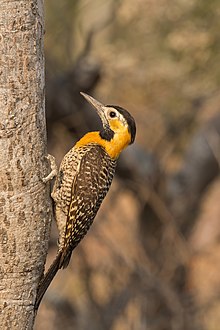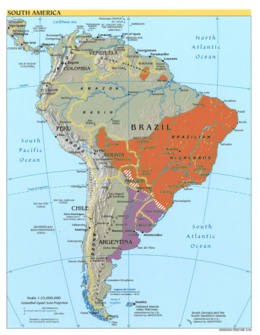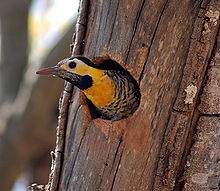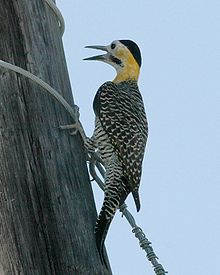Woodpecker
| Woodpecker | ||||||||||||
|---|---|---|---|---|---|---|---|---|---|---|---|---|
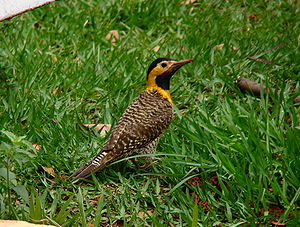
Woodpecker, male of the nominate form |
||||||||||||
| Systematics | ||||||||||||
|
||||||||||||
| Scientific name | ||||||||||||
| Colaptes campestris | ||||||||||||
| ( Vieillot , 1818) |
The field woodpecker ( Colaptes campestris ), sometimes also called Campos woodpecker, is a species from the genus of the gold woodpecker ( Colaptes ) within the subfamily of the real woodpeckers . The species is monotypical. The Colaptes c. campestroides was placed in Artrang in 2014 with the German name Pampaspecht .
The bird, which is almost the size of a gray woodpecker, has an extensive distribution area in central and southeastern South America , where it feeds primarily on various species of ants and termites, which it mainly prey on the ground. The species often lives in small groups. The woodpecker is regionally very common in its area of distribution and is classified by the IUCN as ![]() (= least concern - not endangered).
(= least concern - not endangered).
Appearance
With a maximum body length of 31 centimeters and a weight of up to 192 grams, the species roughly corresponds to the gray woodpecker in terms of size and mass. In its area of distribution it is well known and cannot be confused with any other species of woodpecker. The two very closely related and often hybridizing species woodpecker and pampa woodpecker differ particularly in the color of the throat, forehead and neck.
On a chestnut-colored to gray-black background, the entire upper side is clearly and closely banded and spotted from white to cream-colored. This banding is wider on the shoulders and on the large wing covers than on the back. The wings are dark brown; they have narrow, light brown to white banding. The long tail is black-brown on top. The outer flags of the outer feathers as well as the entire inner control feathers are banded white to cream-colored. The underside is drawn from the chest to the rump on a whitish, yellow breathy ground, clearly blackish like arrowheads. The underside of the wing is yellowish, the wing edges and the wing tip are darkly zoned. The under wing covers have dark markings. The underside of the tail is slightly paler than the upper side, the light-colored banding is more indistinct.
The head is black from the forehead to the nape; the slightly elongated neck feathers can form an indicated tuft. The reins and the region around the eyes are cream-colored, the ear covers, the neck and the upper chest region are conspicuously and intensely dark golden-orange in color and often have a reddish-orange tint towards the abdomen. The throat is drawn very finely in white on a black background. At the base of the beak in the male begins an individually differently developed scarlet streak of beard and limits the black throat color to the ear covers. In the female, the beard stripe is marbled on a black background with white inclusions.
The long, pointed, downwardly curved bill is black, sometimes reddish brown towards the tip. The feet and the four toes are variable greenish-gray to flesh-colored. The eyes are chestnut to reddish brown.
Except for the mentioned difference in the markings in the malar area, the sexes do not differ in terms of their coloration. However, females appear to be around 10 percent lighter than males. Young birds are paler than adults , especially the gold color of the cheeks is less intense in them.
voice
The woodpecker is very shouting. The most common call is a two- or three-syllable whistle, in which the individual syllables merge strongly with one another. Wiiik or kiip call rows are used to delimit the territory. In addition, the species has a number of neighing or shaky sounding vocalizations. In group contact, wick… wick… wick calls can be heard.
distribution and habitat
The woodpecker is widespread in central eastern and southeastern South America. The largely closed distribution area extends from eastern Brazil south to Paraguay and west to the eastern Andean cover in Bolivia . In addition, there are islands of distribution in Suriname and on the lower Amazon . Some islands off the coast are also inhabited by the species. The woodpecker benefits from the increasing deforestation of its habitat and is spreading further west, especially along the major highways.
The species colonizes open land with solitary trees, especially pampas and semi-arid bush steppes ( Caatinga ), as well as larger clear-cutting areas such as those that arise along the road construction projects, pastureland, forest edges and plantations. Nesting trees and a sufficient supply of ants and termites are essential. The species occurs from sea level to heights above the regional tree line. In central Argentina, the highest nesting areas are at 600 meters.
Food and subsistence
Woodpeckers mainly feed on ants and termites . Larger beetles and crickets are also captured. Occasionally it opens the nests of pottery birds and eats their eggs and nestlings.
Field woodpeckers feed mainly on insects living on the ground, but often observe their surroundings from elevated locations. They are often gathered in small groups when foraging for food , often also with the closely related green-banded woodpecker ( Colaptes melanochloros ), which more often than the field woodpecker visits the lower branch and trunk region to forage. Field woodpeckers open the tunnels of ground-dwelling ants and termites with their bills, collect these animals from the surface of the earth, turn leaves with quick beak movements and read insects from their underside, but also chop up termite structures with beak blows. The broken termite structures are regularly used by the giant toucan as breeding caves. When looking for food, they stride, hopping over longer distances. Field woodpeckers occasionally hammer caves about 7 centimeters in diameter into buildings. It is not yet clear whether these are sleeping caves or food stores.
Breeding biology
Due to the considerable north-south expansion of the range of the species, the breeding seasons vary greatly. The breeding season in Suriname begins in January and ends in November for the southernmost populations in Argentina. During this time, the woodpeckers are mainly observed in small groups, which suggests a certain form of social breeding organization. More detailed information on the relationships between the group members is not yet available. The species does not breed in dense colonies, but 5–6 nests within 100 meters have been observed.
The breeding cave is cut into living, but preferably dying or dead trees or tree stumps at different heights (> 12 meters); telegraph poles or wooden structures are also used. Occasionally field woodpeckers hammer their burrows into the nests of tree-dwelling termites, in treeless areas also in termite structures or dig nesting holes in embankments.
The clutch consists of 4–5 eggs; it is brooded by both parents. No information is available about the incubation period and the nestling period. After the young birds have fled out, the family association seems to be preserved for a relatively long time.
Systematics
The woodpecker is one of 19 medium-sized woodpecker species of the genus Colaptes , which are mainly found in Central and South America. The relationships between the genus and other genera of the Picinae have not yet been adequately researched.
For a long time Colaptes c. campestroides has been listed as an independent species Colaptes campestroides since 2014 . Its distribution area connects to that of the field woodpecker to the south. In Paraguay, in southern Brazil and possibly also in northern Argentina there is an area of different widths in which both species occur together. Mixed broods are often observed here. The hybrids apparently have no genetic deficits.
Stock situation
The total distribution area of this species is estimated at almost 6 million square kilometers. So far, the species seems to have benefited from those interventions in the natural environment that create open landscape structures with only individual trees. It can therefore expand its area and increase in population. Quantitative inventory estimates are not available. According to the IUCN, it is safe ( least concern ).
Individual evidence
- ↑ a b c Winkler et al. (1995) p. 325
- ^ Lester L. Short: Foraging Association of Green-Barred Flickers and Campo Flickers in Argentina. In: Wilson Bulletin 81, No. 4, October-December, 1969: pp. 468-470.
- ↑ Lester L. Short and Jennifer FM Horne: Toucans, Barbets and Honeyguides - Ramphastidae, Capitonidae and Indicatoridae . Oxford University Press, Oxford 2001, ISBN 0-19-854666-1 , p. 422
- ↑ Winkler et al. (1995) p. 326
- ^ Eugene M. McCarthy: Handbook of Avian Hybrids of the World . Oxford University Press, 2006. p. 104 ISBN 0-19-518323-1
literature
- Hans Winkler , David A. Christie and David Nurney: Woodpeckers. A Guide to the Woodpeckers, Piculets, and Wrynecks of the World. Pica Press, Robertsbridge 1995, ISBN 0-395-72043-5 , pp. 124-125 and 324-326.
Web links
- Colaptes campestris onthe IUCN 2011 Red List of Threatened Species . Listed by: BirdLife International, 2009. Retrieved December 28, 2011.
- BirdLife International: Species Factsheet - Campo Flicker ( Colaptes campestris ) . Retrieved December 28, 2011.
- Videos, photos and sound recordings of Campo Flicker (Colaptes campestris) in the Internet Bird Collection
- Colaptes campestris at Avibase
- Colaptes campestris in the Integrated Taxonomic Information System (ITIS)
- xeno-canto: sound recordings - Campo Flicker ( Colaptes campestris )
